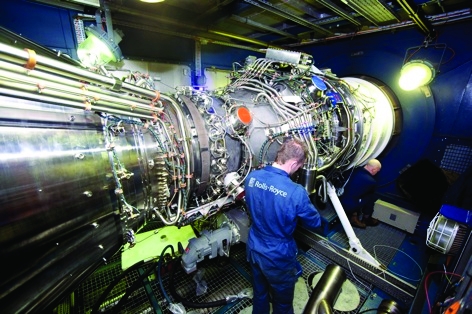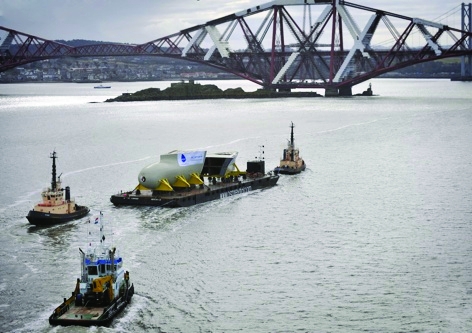The concept of blogging was quite new to me until a couple of weeks ago when I was kindly invited to be a guest blogger for The Engineer, giving regular updates on the work which is well underway to deliver the two new Queen Elizabeth (QE) Class Aircraft Carriers to the Royal Navy. The editorial team thought it would be something that their readers would be interested in, so I would like to welcome you to my first blog entry in what I hope will be a series of many. I hope that you will find my entries interesting and if you have any questions please feel free to send them in and I’ll do my best to answer.
Powering the QE Class
I have recently had the pleasure of visiting both the Rolls Royce works in Bristol to see the second MT30 gas turbine being made ready for factory testing and also to Converteam’s factory in Rugby where the first propulsion motor was at an advanced state of manufacture. It was great to see these powerful pieces of equipment that are so essential to the operation of the aircraft carriers.
Once the diesels are installed, the engine rooms will really start to take shape
The Power and Propulsion (P&P) for the two aircraft carriers is provided through an Integrated Electrical Propulsion (IEP) system. This comprises six electrical generators, four driven by Wartsilla diesel engines and two by Rolls Royce MT30 Gas Turbines. The electrical power is generated at High Voltage 11kV and is used to provide propulsive power through four 20MW Advanced Induction Motors arranged on two propeller shafts. However, it also supplies the carrier’s mission systems and hotel services through ship service transformers which convert the voltage down to 440V for distribution around the ship. The system builds on the experience gained by the Royal Navy through the electrical propulsion systems used on assault ships HMS Albion and Bulwark and the IEP systems on the Type 45 Destroyers. The QE Class use very similar equipment fitted to that of the Type 45 Destroyers, but of course are much larger.

Two of the Wartsilla diesel generators have also been delivered to the BAE Systems’ shipyard in Portsmouth where they will shortly be installed onto their seats in the Forward Machinery Room that is being constructed there. Currently the Machinery Room looks like a huge empty space with lots of pads for machinery seats, holes in the decks and bulkheads ready for pipes and cables. However, once the diesels are installed and the major pipe runs and walkways are fitted ready to be closed off by the structural units above the engine rooms will really start to take shape.
First ship sections delivered
The very forward sections of HMS Queen Elizabeth have been constructed at Babcock’s facility at Appledore in North Devon. It’s a lovely little shipyard and I really enjoy my visits there, it is the only place involved with the Carrier programme (that I know of) where you get Cornish pasties for lunch and a Devon ice cream from the village shop after work!

The bow has been constructed in two sections, the lower part being the bulbous bow, while the upper part is primarily tanks. These two large units were completed in March and were shipped from Appledore to Rosyth on a barge at the start of April. This was the first significant movement of a structural block on the project and was a good opportunity for us and our transportation sub-contractor to refine our processes prior to the much more onerous movement of the massive lower blocks 2, 3 and 4 starting next year.
The detour gave the design team, the general public and local media an opportunity to get a good look at part of the ship
The load out of the bow sections onto the barge went exactly to plan, prior to the official float out of the barge from the dry dock at Appledore on the evening of 31 March. Unfortunately the British weather intervened and strong winds prevented the actual movement of the barge until the following morning, but the well attended ceremony at Appledore was a huge success and a very proud moment for myself, my team and the Devon workforce. Continued strong winds caused the tug and barge to seek shelter at Avonmouth prior to the voyage to Rosyth, where the bow sections were offloaded. However, the detour did at least give the design team, many of whom work in the Bristol area, the general public and even local media an opportunity to get a good look at part of the ship, which they wouldn’t have been able to do otherwise. The units are now sitting on the hardstand outside our offices in Rosyth and are very tangible symbols of the progress being made. It certainly whets the appetite for what is to come!




Red Bull makes hydrogen fuel cell play with AVL
Formula 1 is an anachronistic anomaly where its only cutting edge is in engine development. The rules prohibit any real innovation and there would be...